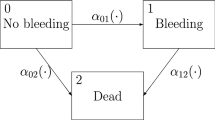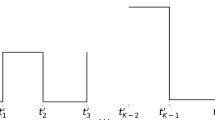Abstract
Multistate models provide important methods of analysis for many life history processes, and this is an area where John Klein made numerous contributions. When individuals in a study group are observed continuously so that all transitions between states, and their times, are known, estimation and model checking is fairly straightforward. However, individuals in many studies are observed intermittently, and only the states occupied at the observation times are known. We review methods of estimation and assessment for Markov models in this situation. Numerical studies that show the effects of inter-observation times are provided, and new methods for assessing fit are given. An illustration involving viral load dynamics for HIV-positive persons is presented.


Similar content being viewed by others
References
Aalen OO, Borgan O, Fekjaer H (2001) Covariate adjustment of event histories estimated from Markov chains: the additive approach. Biometrics 57:993–1001
Aalen OO, Borgan O, Gjessing HK (2008) Survival and Event History Analysis: A Process Point of View. Springer Science + Business Media LLC, New York
Andersen PK, Borgan O, Gill RD, Keiding N (1993) Statistical Models Based on Counting Processes. Springer-Verlag, New York
Andersen PK, Klein JP (2007) Regression analysis for multistate models based on a pseudo-value approach, with applications to bone marrow transplantation studies. Scandinavian Journal of Statistics 34:3–16
Cook RJ (2000) Information and efficiency considerations in planning studies based on two-state Markov process. Journal of Statistical Research 34:161–178
Cook RJ, Lawless JF (2007) Statistical Analysis of Recurrent Events. Springer Science+ Business Media LLC, New York
Cook RJ, Lawless JF (2014) Statistical issues in modeling chronic disease in cohort studies. Statistics in Biosciences 6:127–161
Cook RJ, Lawless JF, Lakhal-Chaieb L, Lee KA (2009) Robust estimation of mean functions and treatment effects for recurrent events under event-dependent censoring and termination: application to skeletal complications in cancer metastatic to bone. Journal of the American Statistical Association 104:60–75
Datta S, Satten GA (2001) Validity of the Aalen-Johansen estimators of stage occupation probabilities and Nelson-Aalen estimators of integrated transition hazards for non-Markov models. Statistics and Probability Letters 55:403–411
Datta S, Satten GA (2002) Estimation of integrated transition hazards and stage occupancy probabilities for non-Markov systems under dependent censoring. Biometrics 58:792–802
de Stavola BL (1988) Testing departures from time homogeneity in multistate Markov processes. Applied Statistics 37:242–250
Gentleman RC, Lawless JF, Lindsey JC, Yan P (1994) Multi-state Markov models for analysing incomplete disease history data with illustrations for HIV disease. Statistics in Medcine 13:805–821
Grennan JT et al (2012) Magnitude of virologic blips is associated with a higher risk for virologic rebound in HIV-infected individuals: a recurrent events analysis. Journal of Infectious Diseases 205:1230–1238
Hwang W, Brookmeyer R (2003) Design of panel studies for disease progression with multiple stages. Lifetime Data Analysis 9:261–274
Jackson CH (2011) Multi-state models for panel data: the msm package for R. Journal of Statistical Software 38(8):1–28
Kalbfleisch JD, Lawless JF (1985) The analysis of panel data under a Markov assumption. Journal of the American Statistical Association. 80:863–871
Kalbfleisch JD, Lawless JF (1989) Some statistical methods for panel life history data. In: Proceedings of the Statistics Canada Symposium on the Analysis of Data in Time. Ottawa, Statistics Canada, pp 185–192
Klein JP, Shu Y (2002) Multi-state models for bone transplantation studies. Statistical Methods in Medical Research 11:117–139
Kvist K, Andersen PK, Angst J, Kessing LV (2010) Event dependent sampling of recurrent events. Lifetime Data Analysis 16:580–598
Lin H, Scharfstein DO, Rosenheck RA (2004) Analysis of longitudinal data with irregular, outcome-dependent follow-up. Journal of the Royal Statistical Society, Series B 66:791–813
Mandel M, Betensky RA (2008) Estimating time-to-event from longitudinal ordinal data using random effects Markov models: application to multiple sclerosis progression. Biostatistics 9:750–764
Mehtala J, Auranen K, Kulathinal S (2011) Optimal designs for epidemiologic longitudinal studies with binary outcomes. Statistical methods in medical research. doi:10.1177/0962280211430663
Moler C, Van Loan C (2003) Nineteen dubious ways to compute the exponential of a matrix, twenty-five years later. SIAM Review 45:3–49
O’Keeffe AG, Tom BDM, Farewell VT (2011) A case-study in the clinical epidemiology of Psoriatic arthritis: Multistate models and causal arguments. Journal of the Royal Statistical Society, Series C 60:675–699
Raboud J, Loutfy MR, Su D, Bayoumi AM, Klein MB, Cooper C, Machouf N, Rouke S, Walmsley S, Rachlis A, Harrigan R, Smieja M, Tsoukas C, Montaner JS, Hogg RS (2010) Regional differences in rates of HIV-1 viral load monitoring in Canada: Insights and implications for antiretroviral care in high income countries. BMC Infectious Diseases 10:40
Satten GA, Sternberg MR (1999) Fitting semi-Markov models to interval-censored data with unknown initiation times. Biometrics 55:507–513
Titman AC (2009) Computation of the asymptotic null distribution of goodness-of-fit tests for multi-state models. Lifetime Data Analysis 15:519–533
Titman AC, Sharples LD (2010a) Model diagnostics for multi-state models. Statistical Methods in Medical Research 19:621–651
Titman AC, Sharples LD (2010b) Semi-Markov models with phase-type sojourn distributions. Biometrics 66:742–752
Titman AC (2011) Flexible nonhomogeneous Markov models for panel observed data. Biometrics 67:780–787
White H (1982) Maximum likelihood estimation of misspecified models. Econometrica 50:1–26
Acknowledgments
This research was supported in part by a grant to J.F. Lawless from the Natural Sciences and Engineering Research Council of Canada. The authors thank Dr. Janet Raboud and the CANOC project, which was supported by funding from Emerging Team Grant 53444 (Dr. Robert Hogg, PI) from the Canadian Institutes of Health Research, for the HIV viral load data and for valuable discussion. They also thank Ker-ai Lee for assistance in managing the data, and Richard Cook and Brian Tom for helpful comments. Finally, the authors are grateful for comments by two anonymous reviewers which led to substantial improvements in the paper.
Author information
Authors and Affiliations
Corresponding author
Rights and permissions
About this article
Cite this article
Lawless, J.F., Nazeri Rad, N. Estimation and assessment of markov multistate models with intermittent observations on individuals. Lifetime Data Anal 21, 160–179 (2015). https://doi.org/10.1007/s10985-014-9310-z
Received:
Accepted:
Published:
Issue Date:
DOI: https://doi.org/10.1007/s10985-014-9310-z




